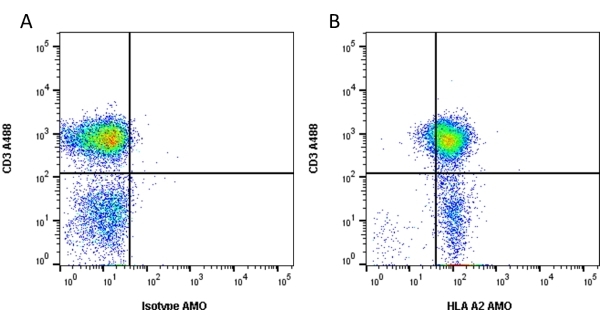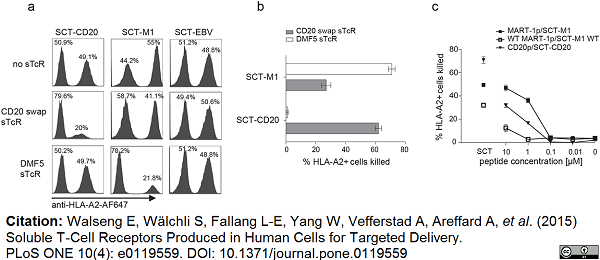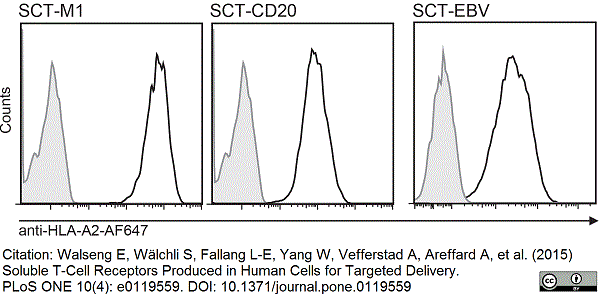HLA A2 antibody | BB7.2



Mouse anti Human HLA A2:RPE
- Product Type
- Monoclonal Antibody
- Clone
- BB7.2
- Isotype
- IgG2b
- Specificity
- HLA A2
| Mouse anti Human HLA A2 antibody, clone BB7.2 recognizes the human HLA-A2 histocompatability antigen. The epitope recognized by this antibody has been studied extensively and would appear to include the carboxy-terminus of the alpha-2 helix and a turn on one of the underlying beta strands. Mouse anti Human HLA A2 antibody, clone BB7.2 may be used for the flow cytometric detection of HLA-A2 expression and has also been used for immunoaffinity purification of HLA-A2 molecules. Functionally Mouse anti Human HLA A2 antibody, clone BB7.2 is reported to inhibit MHC restricted cellular cytotoxicity. |
- Target Species
- Human
- Product Form
- Purified IgG conjugated to R. Phycoerythrin (RPE) - lyophilized
- Reconstitution
- Reconstitute with 1.0 ml distilled water
- Preparation
- Purified IgG prepared by affinity chromatography on Protein G from tissue culture supernatant.
- Buffer Solution
- Phosphate buffered saline
- Preservative Stabilisers
- 0.09% sodium azide (NaN3)
1% bovine serum albumin
5% sucrose - Immunogen
- Papain solubilized HLA-A2
- Fusion Partners
- Spleen cells from immunized BALB/c mice were fused with cells of the mouse NS1 myeloma cell line
- Max Ex/Em
-
Fluorophore Excitation Max (nm) Emission Max (nm) RPE 488nm laser 496 578 - Regulatory
- For research purposes only
- Guarantee
- 12 months from date of despatch
After reconstitution store at +4°C.
DO NOT FREEZE.
This product is photosensitive and should be protected from light.
Should this product contain a precipitate we recommend microcentrifugation before use.
| Application Name | Verified | Min Dilution | Max Dilution |
|---|---|---|---|
| Flow Cytometry | Neat |
- Flow Cytometry
- Use 10μl of the suggested working dilution to label 106 cells or 100μl whole blood.
How to Use the Spectraviewer
Watch the Tool Tutorial Video ▸- Start by selecting the application you are interested in, with the option to select an instrument from the drop down menu or create a customized instrument
- Select the fluorophores or fluorescent proteins you want to include in your panel to check compatibility
- Select the lasers and filters you wish to include
- Select combined or multi-laser view to visualize the spectra
| Description | Product Code | Applications | Pack Size | List Price | Your Price | Quantity | |
|---|---|---|---|---|---|---|---|
| Mouse IgG2b Negative Control:RPE | MCA691PE | F | 100 Tests | Log in | |||
| List Price | Your Price | ||||||
| Log in | |||||||
| Description | Mouse IgG2b Negative Control:RPE | ||||||
| Description | Product Code | Applications | Pack Size | List Price | Your Price | Quantity | |
|---|---|---|---|---|---|---|---|
| Human Seroblock | BUF070A | F | 50 Test | Log in | |||
| List Price | Your Price | ||||||
| Log in | |||||||
| Description | Human Seroblock | ||||||
| Human Seroblock | BUF070B | F | 200 Test | Log in | |||
| List Price | Your Price | ||||||
| Log in | |||||||
| Description | Human Seroblock | ||||||
References for HLA A2 antibody
-
Parham, P. & Brodsky, F.M. (1981) Partial purification and some properties of BB7.2. A cytotoxic monoclonal antibody with specificity for HLA-A2 and a variant of HLA-A28.
Hum Immunol. 3 (4): 277-99. -
Hogan, K.T. & Brown, S.L. (1992) Localization and characterization of serologic epitopes on HLA-A2.
Hum Immunol. 33 (3): 185-92. -
Drukker, M. et al. (2006) Human embryonic stem cells and their differentiated derivatives are less susceptible to immune rejection than adult cells.
Stem Cells. 24 (2): 221-9. -
Pantenburg, B. et al. (2010) Human CD8(+) T cells clear Cryptosporidium parvum from infected intestinal epithelial cells.
Am J Trop Med Hyg. 82:600-7. -
Duncan, L.M. et al. (2010) Stabilization of an E3 ligase-E2-ubiquitin complex increases cell surface MHC class I expression.
J Immunol. 184: 6978-85. -
Wang, B. et al. (2004) Identification of an HLA-A*0201-restricted CD8+ T-cell epitope SSp-1 of SARS-CoV spike protein.
Blood. 104: 200-6. -
Wooldridge, L. et al. (2007) Enhanced immunogenicity of CTL antigens through mutation of the CD8 binding MHC class I invariant region.
Eur J Immunol. 37: 1323-33. -
Wooldridge, L. et al. (2010) MHC class I molecules with Superenhanced CD8 binding properties bypass the requirement for cognate TCR recognition and nonspecifically activate CTLs.
J Immunol. 184: 3357-66.
View The Latest Product References
-
Popovic, J. et al. (2011) The only proposed T-cell epitope derived from the TEL-AML1 translocation is not naturally processed.
Blood. 118 (4): 946-54. -
Schmidt, J. et al. (2011) Reversible Major Histocompatibility Complex I-Peptide Multimers Containing Ni2+-Nitrilotriacetic Acid Peptides and Histidine Tags Improve Analysis and Sorting of CD8+ T Cells.
J Biol Chem. 286: 41723-35. -
Brooks, S.E. et al. (2015) Application of the pMHC Array to Characterise Tumour Antigen Specific T Cell Populations in Leukaemia Patients at Disease Diagnosis.
PLoS One. 10 (10): e0140483. -
Rothe, K. et al. (2016) Latent Cytomegalovirus Infection in Rheumatoid Arthritis and Increased Frequencies of Cytolytic LIR-1+CD8+ T Cells.
Arthritis Rheumatol. 68 (2): 337-46. -
De Angelis Rigotti, F. et al. (2017) MARCH9-mediated ubiquitination regulates MHC I export from the TGN.
Immunol Cell Biol. 95 (9): 753-64. -
Kim, J.Y. et al. (2017) Detection of Donor-Derived Microparticles in the Peripheral Blood of a Hand Transplant Recipient During Rejection.
Transplant Direct. 3 (3): e131. -
Dockree, T. et al. (2017) CD8+ T-cell specificity is compromised at a defined MHCI/CD8 affinity threshold.
Immunol Cell Biol. 95 (1): 68-76. -
Sun, W. et al. (2018) A modified HLA-A*0201-restricted CTL epitope from human oncoprotein (hPEBP4) induces more efficient antitumor responses.
Cell Mol Immunol. 15 (8): 768-81. -
Obenaus, M. et al. (2015) Identification of human T-cell receptors with optimal affinity to cancer antigens using antigen-negative humanized mice.
Nat Biotechnol. 33 (4): 402-7. -
Walseng, E. et al. (2015) Soluble T-cell receptors produced in human cells for targeted delivery.
PLoS One. 10 (4): e0119559.
MCA2090PE
If you cannot find the batch/lot you are looking for please contact our technical support team for assistance.
Please Note: All Products are "FOR RESEARCH PURPOSES ONLY"
View all Anti-Human ProductsAlways be the first to know.
When we launch new products and resources to help you achieve more in the lab.
Yes, sign me up

